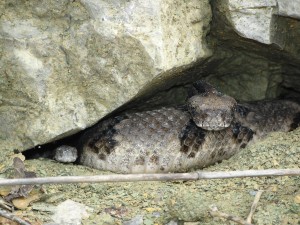Movement ecology of rattlesnakes and conservation genetics of snake hibernacula
Dr. Anderson has an ongoing interest in movement ecology and conservation genetics of rattlesnakes, stemming from his Ph.D. work on the timber rattlesnake (Crotalus horridus). He is particularly interested in the effects of anthropogenic landscape features on patterns of dispersion and the implications of movement and mating patterns for conservation genetic management of overwintering populations (a.k.a. snake dens/hibernacula).

For the timber rattlesnake patterns of genetic variation among hibernacula may be driven by the movement patterns of females and their offspring. Picture by “Kevin”.
Because snakes are notoriously difficult to study, much of the work the lab has moved towards systems that are more tractable doing spatial statistics; nevertheless, our lab is fully equipped for working with (venomous) snakes and we welcome motivated students who want to do snake research.
